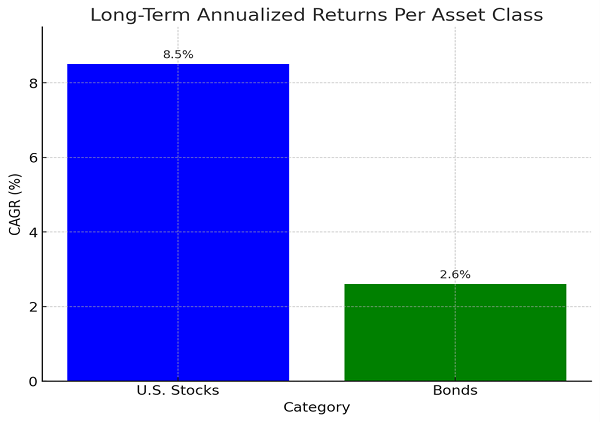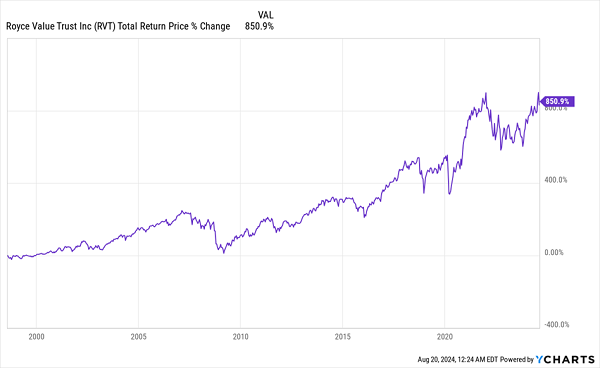When I see people touting the 60/40 portfolio, I kind of feel like Haley Joel Osment’s character in the Sixth Sense. But instead of seeing dead people, I see dead ideas.
You likely know what I’m talking about: a portfolio that seeks to automatically balance risk by holding 60% in stocks and 40% in bonds.
It sounds sensible enough, but history shows that people who invest by this rule have been leaving a lot of money on the table for a long time:
60/40 Portfolio Pays Too High a Price for Low Volatility

One quick glance at US stocks, seen above in purple through the Vanguard Total Stock Market ETF (VTI), and bonds, in orange through the Vanguard Total Bond Market ETF (BND), over the last decade shows a problem. One of these funds is sleeping on the job.
The problem is bonds, which have had about a 2.6% annualized return over the long term, and US stocks, which have had an 8.5% annualized return over the long term.

Source: CEF Insider
First, this should not shock anyone. Bonds are supposed to return less over the long term—after all, you invest in them to get income, and income is very valuable to many investors, hence the overall lower long-term return. The inherently higher risk of US stocks, meantime, produces bigger returns.
The math here is simple: if we put $1 million in US stocks and wait two decades, we would have $5.1 million in assets, going by the historical returns above. That’s a lot more than the $670,000 profit we’d get by putting that money in bonds. Clearly, a broad bond portfolio is going to wear down our profits, which is why this happens.
The 60/40 portfolio has resulted in a profit, but a profit that is smaller than the stock-only portfolio by an eye-watering $1,770,000!
By putting a heavy weighting toward bonds, we have literally left nearly $2 million on the table in a decade; the longer you devote yourself to the 60/40 portfolio, the more money you’re missing out on.
The Liquid Alternative
The problem with stocks is, well, what if you can’t wait a decade? What if you need income now? There is a simple solution: closed-end funds (CEFs).
While the 60/40 portfolio is the old idea—it’s been around for more than 50 years—of how to get income (by sacrificing total returns), CEFs are a much better idea: turn capital gains into a reliable income stream.
Take, for instance, the 7.4%-yielding Royce Small Cap Trust (RVT), an equity CEF that was launched in 1986 and has been delivering income ever since.
RVT Converts Stock Gains Into Income

Due to RVT’s high yield, you see your profits in the form of dividends that, in the case of this fund, are paid out quarterly.
RVT is no fly-by-night shop, either. Not only has the fund’s history spanned nearly four decades, but it’s one of the larger equity CEFs, managing over a billion dollars in assets for investors who can buy and sell their shares whenever they want.
That’s a clear benefit of investing in RVT, but here’s the thing: I don’t think this is the best CEF on the market now. There are literally dozens of better ones. But sometimes it is a strong buy, like when its price goes to a sudden, steep discount to net asset value (NAV, or the value of its underlying portfolio).
Right now isn’t quite that time: even though the fund’s discount sits at 11.7% as I write this, it’s actually been much cheaper this year:
This “Dividend Machine” Is on Sale, But We’ll Wait for a Better Deal

That makes RVT not a bad pick today, but as I write this, about the vast majority of CEFs trade at discounts, so we’ve got plenty of choices in the bargain bin!
The key takeaway here is that once you peer into the CEF universe, you begin to see opportunities not just to capture the profits that 60/40 investors miss. You’ll also discover how to create a diversified portfolio for all markets, as CEFs come from all kinds of sectors while delivering average yields over 7%.
So let’s toss the 60/40 portfolio in the dustbin—and instead look to the superior future income and gains that CEFs can provide.
Grab These 4 “Bargain-Bin” Dividends—Yielding an Incredible 9.8%—NOW
As I just said, there are many bargain-priced CEFs offering far bigger upside, and far bigger dividends, than RVT offers.
Right now, for example, I’m urging all investors to buy 4 other CEFs yielding much more. I’m talking 9.8% average dividends here. Payouts that put just about every other option—stocks, bonds, the 60/40 portfolio—to shame.
And thanks to their unusual discounts, you don’t have to sacrifice gain potential to tap into those high payouts: all 4 are so cheap now that I’m calling for 20%+ price upside over the next 12 months!
Don’t miss your chance to buy these 4 high-yielding CEFs before their discounts disappear—and their prices take off. Click here and I’ll tell you more about them and give you the opportunity to download a FREE Special Report revealing their names and tickers.
